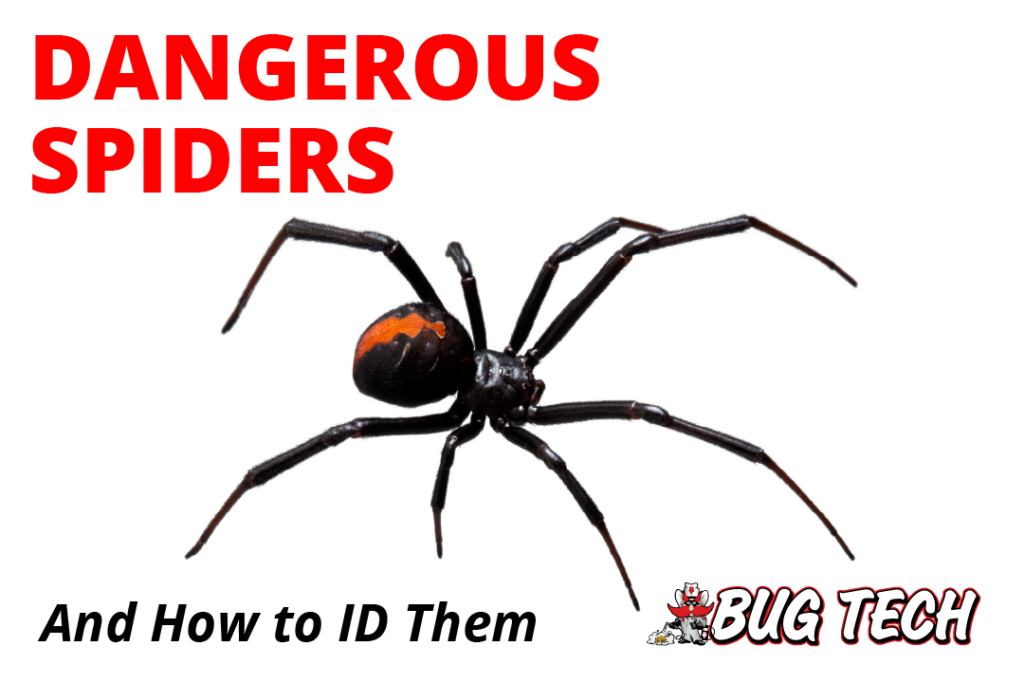Dangerous Spiders and How to Identify them

While Texas is known for its larger-than-life reputation, it’s also home to a diverse array of wildlife, including many species of spiders. According to the Texas Parks and Wildlife Department, there are almost 1,000 species of spiders found in Texas, but only four of those are considered potentially dangerous to humans and they live in West Texas and The Texas Panhandle.
It’s important to note that while these spiders may have venom that can potentially cause harm to humans, they are not typically aggressive toward humans and will generally only bite if provoked or threatened. In fact, spiders play an important role in the ecosystem by controlling populations of insects and other small animals.
Venomous vs. Poisonous: What’s the Difference?
Some use the terms “venomous” and “poisonous” almost interchangeably, thinking that poisonous is simply the deadlier term of the two. However, these terms mean two different things:
- Venomous: A toxin, usually from a sting or bite, is injected into you.
- Poisonous: A toxin is inhaled, swallowed or absorbed by the skin into the body.
Some animals, insects and plants can be poisonous if you accidentally ingest them. All arachnids except two subgroups contain venom glands that release secretions that act as an “insecticide” to catch prey. Only one spider is known to attack humans unprovoked—the funnel web spider found in Australia. Venomous spiders in North America and South America can cause “medically significant” symptoms in humans, such as pain and swelling at the site of the bite, respiratory distress, kidney dysfunction, neurotoxic effects, hypertension and pulmonary edema.
The yellow sac spider is often mistaken for the brown recluse but doesn’t have the fiddle shape on its back. While the yellow sac spider can give you a painful bite, it’s only dangerous if you’re allergic. However, the brown recluse is venomous and dangerous to humans. Of the 900 species of arachnids in the state, Texas Parks and Wildlife reports that only two venomous spiders are considered potentially deadly to humans: the brown recluse and the black widow. However, the brown widow is also common in Texas, less discussed and similarly venomous.
The bites of the brown recluse, brown widow and black widow, found in Texas, may also cause such significant and potentially deadly effects. Though serious spider bites can be fatal, mortality from a spider bite is considered rare.
Dangerous Brown and Black Spiders In Lubbock & Amarillo
There’s an ongoing myth that black spiders aren’t as dangerous as brown spiders. This may be because the brown widow is considered to have more potent venom than the black widow. However, the dangerous part of a spider’s bite is less related to color and more associated with the type of spider.
Some spider bites may cause an allergic reaction due to their venom, while other spider bites from brown recluses, brown widows and black widows cause severe symptoms or become deadly if not treated in time. Below, we’ll discuss these three deadly spiders and help you identify the yellow sac spider since it is often mistaken for the brown recluse.
Brown Recluse
The brown recluse is named for its solitary nature since it hides during the day and comes out at night. This arachnid prefers warm and dry spaces like barns, closets and even shoes. It’s always a good idea to shake out shoes before wearing them. Brown recluses are more likely to bite if trapped nearby or against the skin.
Characteristics: The brown recluse reaches about half an inch in length and has six eyes in total, grouped into a semicircle. Identify the brown recluse by looking for the dark violin-shaped marking on its back. The neck of the violin points toward the rear of the spider on adults, but it’s less visible on young spiders. This feature also lends the brown recluse the nickname “the fiddleback spider.”
Bite: The initial bite will develop a pale center with auroral redness around it within three to eight hours. The site may also be bluish with irregular edges and have a blister at the center. Common symptoms include redness, swelling, dizziness, nausea and vomiting. A brown recluse spider bite can cause skin tissue deterioration at the site, leading to a deep ulcer lasting weeks to months. The symptoms are often confused with a Staph infection. If you suspect a bite from this spider, seek medical attention as soon as possible.
Brown Widow
The brown widow first entered the United States through Texas and expanded its range to the east coast and beyond in the 1990s. The brown widow is also a timid species and tends to avoid humans. It builds webs to catch its prey in entryway corners, garages, storage closets and empty containers like buckets.
Characteristics: The black widow can reach up to an inch on average. It looks like the black widow, identifiable by an hourglass shape on the underside of the abdomen. However, the hourglass on the brown widow is lighter in color, yellowish-orange or reddish-orange.
Bite: Males and immature brown widows don’t bite. The female’s bite, though rare, will cause a typical initial reaction—the site will become painful and red with swelling at the center. According to data analysis conducted by entomologist Joe Ballenger, one of the worst symptoms you may experience is stomach cramps, potentially differentiating it from the bite of the black widow. A 2020 case study, published by Cureus, reported a 41-year-old male experiencing significant pain, a circular red rash around the site of the bite and feeling nauseated—though no skin deterioration, labored breathing or other concerning symptoms. Seek medical attention immediately.
Black Widow
Black widows are among the most common dangerous spiders in the United States. Like most spiders, it prefers quiet places like cellars, storage areas and abandoned buildings. This spider is known as the black widow due to the reputation of some of the females devouring the males once they have mated.
Characteristics: The black widow is about half an inch long as an adult and is the only shiny black spider. You can identify this spider by looking for the red hourglass mark on its abdomen, which may be more prominent in males and younger spiders. Only female is considered dangerous to humans.
Bite: Two faint pinpricks with localized swelling and redness will appear, along with pain, within one to three hours of the bite. The pain can persist for a few days and may spread to the back and abdomen. Other symptoms include sweating, tremors, nausea, vomiting and a slow pulse. If left untreated, the person bitten may risk complications due to infection, so it’s best to seek medical attention if you show these signs and symptoms.
Potential for Harm Due to Venomous Spiders in the Home
Most spiders are harmless and can do a good job of keeping your home free of other insects. However, in most cases, they are unwelcome guests. Even the severely venomous ones won’t bite unless provoked, and even normal movement can make them feel threatened. Be careful about moving around items that are potential hiding spots and take care with spider webs.
There are no poisonous spiders in Texas, but there are a few potentially dangerous, venomous spiders to watch out for: the brown recluse, the brown widow and the black widow. You may also have a serious reaction to the yellow sac spider, often mistaken for the brown recluse. Other spider bites can be severe if you are allergic. Always seek medical attention as soon as possible.
If you notice any of these spiders in your home, Bug Tech can immediately handle the situation professionally and carefully. We offer a free estimate with every consultation.
